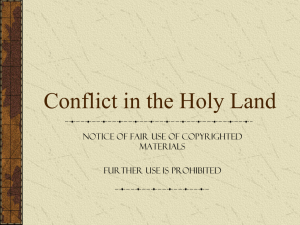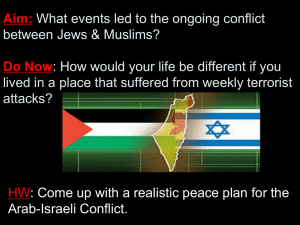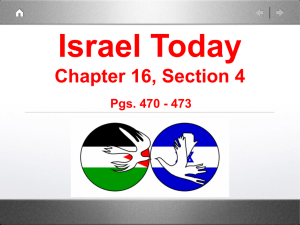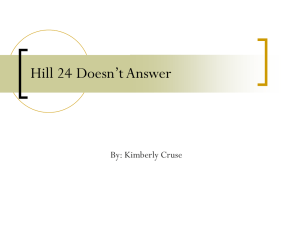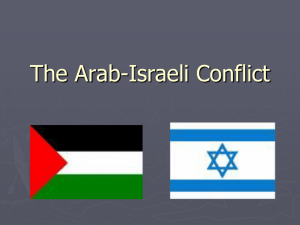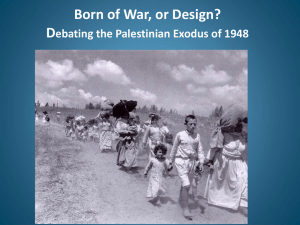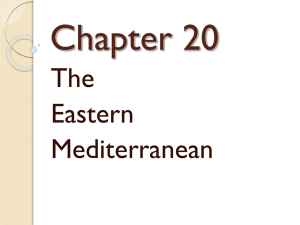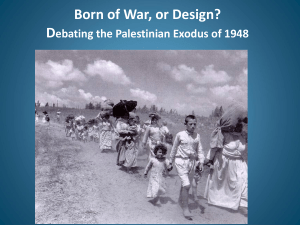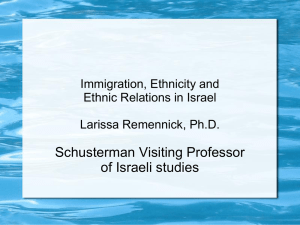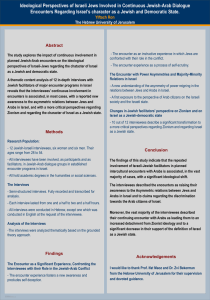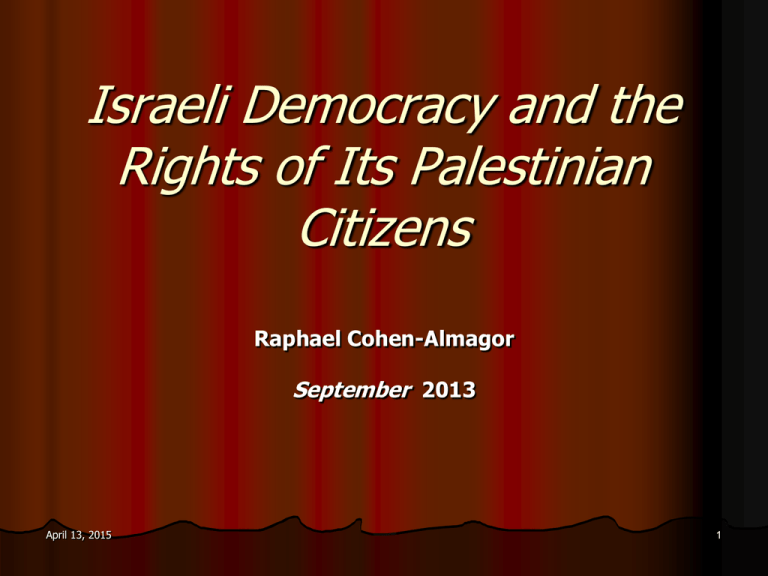
Israeli Democracy and the
Rights of Its Palestinian
Citizens
Raphael Cohen-Almagor
September 2013
April 13, 2015
1
Universal Declaration of Human
Rights
All human beings are born free and equal
in dignity and rights. They are endowed
with reason and conscience and should
act towards one another in a spirit of
brotherhood.
Article 1, Universal Declaration of Human
Rights
April 13, 2015
2
Preliminaries
The Palestinians comprise some 20% of
the Israeli population.
According to the Central Bureau of
Statistics, there were 1,573,000 IsraeliPalestinians in 2010.
80% are Muslims.
April 13, 2015
3
Preliminaries
Most of the Arabs reside in the Galilee in
north Israel.
Smaller numbers live in the so-called
Triangle area at the centre of Israel and in
the Negev desert in the south (mostly
Bedouins).
April 13, 2015
4
Preliminaries
Israel was established as a Jewish
democracy
Based on Liberal-Democratic values
AND
Jewish values
April 13, 2015
5
Preliminaries
April 13, 2015
6
Preliminaries
Between 1948 and 1966, Israeli-Arabs lived
under military rule.
Their rights and liberties were severely limited
as they were regarded with suspicion as a
security threat.
With the abolishing of the military rule in 1966,
the Israeli-Arabs began their integration into
society as citizens with equal claims to those of
the Jewish majority.
7
April 13, 2015
Preliminaries
The relationships between the Jewish
majority and the Arab minority remain far
from ideal.
In 2007, 66% of the Arabs characterized
their relationships with Jews as “not
good”, and 80% thought they were
discriminated against.
8
April 13, 2015
Arguments
The litmus test for measuring the extent
of democratization of any given society is
the status of minorities.
April 13, 2015
9
Arguments
I argue for accommodating the interests
of the Israeli-Palestinians, striving to
safeguard equal rights and liberties for all
citizens notwithstanding nationality,
religion, race or colour, and insisting that
citizens have also duties to fulfil.
April 13, 2015
10
Arguments
The most basic norms
democracy has to
secure are
respecting others
as human beings,
and not to inflicting
harm upon others.
April 13, 2015
11
Arguments
The key to the success of Zionism is
integration into the region.
The key to Israel’s integration into the
region is the integration of Arabs as
equals in Israel.
April 13, 2015
12
Society’s Profile
No shared raison d'être
20% wish to transform democracy into
theocracy
20% do not endorse the Zionist ethos
20% of the population are immigrants from
the former Soviet Union where no
democracy existed
April 13, 2015
13
Main Schisms
Between Jews and Arabs
Between secular and religious people
Between Israel and the Occupied
Territories
April 13, 2015
14
Israeli-Palestinians
Formal v. Full Citizenship
Discrimination
Racism
April 13, 2015
15
Is Israel a Liberal
Democracy?
In The Law of Peoples, John Rawls drew a
distinction between liberal and illiberal societies.
Liberal societies are pluralistic and peaceful;
they are governed by reasonable people who
protect basic human rights.
In contrast, nonliberal societies fail to treat their
people as truly free and equal. They adopt
norms based on compulsion and coercion
April 13, 2015
16
Israel is a Jewish democracy
The framework of governance is
democratic, but its underpinning concepts
give precedence to Judaism over the
Respect for Others Principle, and the
Harm Principle.
Consequently, Israel adopts illiberal
policies and practices that are
discriminatory in nature, preferring Jews
over others.
April 13, 2015
17
Positive Data
Mortality rates among Israeli Palestinians
have fallen by over two-thirds since the
establishment of Israel, while life
expectancy has increased 30 years,
reaching 78.5 (women 80.7, men 76.3) in
2009.
Infant-mortality rates have similarly been
significantly reduced from 56 per 1,000
live births in 1950 to 6.5 in 2008.
April 13, 2015
18
Positive Data
As for education, adult illiteracy rates
among Israeli Palestinians dropped from
57.2% (79% among women) to 7.7%
(11.7% among women).
In 1961, less than half of Arab children
attended school, with only 9% acquiring
secondary or higher education.
April 13, 2015
19
Positive Data
By 1999, 97% of Arab children attended
schools.
Fifty years ago, a mere 4% of Arab
teachers held academic degrees;
by 1999, the figure had vaulted to 47%.
April 13, 2015
20
Home?
According to the 2012 Democracy Index,
27.7% of the Israeli-Palestinians greatly
feel a sense of belonging to the State of
Israel, while 38.2% feel somewhat a sense
of belonging
33.5% hardly feel this way.
April 13, 2015
21
Discrimination
30% of the Jews felt hatred towards Arabs;
46% of the Jewish respondents did not wish to
have Arab neighbours;
30% of Arab job seekers felt negative
discrimination;
¼ of Jewish employers (22%) discriminated
against Arab applicants in the hiring process.
April 13, 2015
22
Discrimination
46.6% of Arabs very much agreed with the
statement that they were discriminated against;
28.3% agreed with this statement (total 74.9%).
The majority of Jews did not share this view.
Only 13.8% of Jews very much agreed that
Arabs were discriminated against and 24.5%
agreed with this statement (total 38.3%).
April 13, 2015
23
Poverty
Some 50% of the Israeli-Arab population lives in
poverty.
The poverty rate among Arab families has
significantly increased since the 1990s, rising
from 35% in 1990 to 45% in 2002 and to 57.6%
in 2006.
In 2009, 53.5% of the Arabs lived in poverty,
compared to 15.2% of the Jews.
Overall, while they comprise 20% of the
population, Arabs constitute 37.8% of the poor.
April 13, 2015
24
Job Market
In 2010, the unemployment rate among Arabs
was 8%, compared to 6.4% among Jews.
In 2009, almost 50% of the manpower in
construction, commerce and industry were
Arabs.
On average, Arab men earn 60 percent of the
national average wage, while Arab women earn
70 percent of the average wage.
April 13, 2015
25
Income
In 2006, the average monthly gross
income of Arab households was NIS 7,590
compared to NIS 13,245 which was the
average monthly gross income of Jewish
households.
In 2009, the hourly pay for Arabs was 62%
less than that of the Jews: NIS 27,
compared to NIS 44 hourly pay for Jews.
April 13, 2015
26
Arab Localities
Tend to be poor.
Lack of resources.
Of the 535 communities that were
categorized as “nationally significant”, only
four were Arabs and all four were small
with little population.
April 13, 2015
27
Religious Budget
The Ministry of Religions allocates only
2% of its budget for Palestinian concerns.
April 13, 2015
28
Education
Rate of matriculation certificates obtained
by Jewish students was nearly double that
of Arab students, 59.74% compared to
31.94%.
31% of Palestinians qualified for university
acceptance on the matriculation exam,
compared to 76 percent of Jews.
Only 11% of the BA students were Arabs.
April 13, 2015
29
Education
In the advanced degrees, Arab MA
students constitute 7%
PhD: 3%.
Arabs constitute only 2% of the academic
staff.
April 13, 2015
30
Land
Arab citizens are discriminated in having access
to land, in land planning, in rural and urban
development, and in housing provisions.
Arabs own only 2.5 percent of Israel’s lands.
The lack of town plans and planning permissions
for Palestinian towns is one of the main causes
of inequality and of the failure of the Palestinian
citizens to fulfill their economic potential.
April 13, 2015
31
Land and Essential Services
More than half of the Bedouins, about 90,000 of
170,000 people, are deprived of their ancestral
lands, living in what the Israeli government terms
“illegally constructed villages”, still without public
utilities or basic services.
36 Bedouin settlements in the Negev are
unrecognized (without essential services: water,
electricity, gas, drainage, state education and
health).
Some 45,000 structures are at risk of demolition.
April 13, 2015
32
Land
The Bedouin reside in 300-350,000 dunam (1
dunam=1000 m2) which is 3% of the Negev (13
million dunam).
Up until the establishment of the State of Israel
in 1948, the Bedouin settled 2-3 million dunam
of the Negev.
April 13, 2015
33
Civil Service
In 1992 only 2.1% of civil servants were
Palestinians.
During the Rabin-Peres governments,
there was a significant improvement to
4%.
in 2010, 7% of civil servants were
Palestinians.
April 13, 2015
34
Civil Service
Israeli Arabs, except for Druze and the
Circassian, are exempted from serving in
the Israeli Defence Force (IDF).
The exemption, however, proved to be a
double-edge sword as it serves as a
recipe for discrimination.
It is for the benefit of the Palestinians to
remove this obstacle to their full
integration into Israeli society.
April 13, 2015
35
Civil Service
Palestinians can serve in the local
hospitals, the Red Magen David health
service, the fire brigades, the community
police, local hospices and nursing homes,
charity and human rights organizations.
April 13, 2015
36
Representation
To date, there has been one Arab
minister, Raleb Majadele.
This should be corrected.
In 2005, there were 546 directors in
governmental companies; of them 53
(9.7%) were Arabs.
April 13, 2015
37
Representation
Delegates of the Arab minority should be
represented, in accordance with their size
in society, in the Knesset and in the
government.
At the same time, Israel would like to see
from all its citizens, without exception, a
real and strong commitment to the state,
to peace, and to the struggle against
terror.
April 13, 2015
38
Declarations, Language
and Symbols
David Ben-Gurion: “the Arabs who
reside in Eretz (Land of) Israel enjoy
all the rights that residents in any
democratic country enjoy, and a
Jewish state is possible only as a
democratic country”.
April 13, 2015
39
Declarations, Language
and Symbols
David Ben-Gurion: “In accordance with
my moral belief we do not have the
right to deprive a single Arab child,
even if our reward resulting from this
deprivation would be the fulfillment of
all our wishes”.
April 13, 2015
40
Declarations, Language
and Symbols
Ze’ev Jabotinsky: “First of all, I consider
it utterly impossible to eject the Arabs
from Palestine. There will always be
two nations in Palestine – which is
good enough for me, provided the
Jews become the majority”.
April 13, 2015
41
Declarations, Language
and Symbols
Ze’ev Jabotinsky: ”I am prepared to
take an oath binding ourselves and
our descendants that we shall never
do anything contrary to the principle
of equal rights, and that we shall
never try to eject anyone. This seems
to me a fairly peaceful credo”.
April 13, 2015
42
Declarations, Language
and Symbols
Moshe Sharett: “being surrounded by
Arab countries all around but the sea,
we have interest of self-preservation
to keep our conscience, integrity and
hands clean and pure”.
April 13, 2015
43
Declarations, Language
and Symbols
Moshe Sharett: “The State of Israel will
not deny the Jewish spiritual heritage
whose principles are the love of
people, the pursuit of peace and
loyalty to justice. It will not betray the
moral ideals of the Zionist movement
whose foundations are liberty, equality
and social progress”.
April 13, 2015
44
Declarations, Language
and Symbols
Yigal Alon said: Jews, who became a symbol
for prosecuted and oppressed minorities,
should show exemplary treatment of
minorities in their own country but instead
they consciously employ continued
discriminatory policies against other
religions.
“Israel must be able to prove that it can treat
its minorities in the most enlightened way”.
April 13, 2015
45
Declarations, Language
and Symbols
Benjamin Netanyahu: “there is no
scope for discrimination in the State of
Israel. We are obligated to equality of
opportunity for everyone. The Arab
sector is a central engine of growth for
Israeli economy which has yet to be
fully utilized”.
April 13, 2015
46
Declarations, Language
and Symbols
Benjamin Netanyahu: “integrating
minorities in the job market would
contribute not only to the Arabs but to
Israel at large.
This is Israel’s national interest and
Israel should encourage this
integration”.
April 13, 2015
47
The Declaration of
Independence
The Declaration of Independence holds
that Israel will foster the development
of the country for the benefit of all its
inhabitants; that it will be based on
the foundations of liberty, justice and
peace;
April 13, 2015
48
The Declaration of
Independence
that it will uphold complete equality of
social and political rights to all of its
citizens irrespective of religion, race or
sex, and that it will guarantee freedom
of religion, conscience, language,
education and culture.
April 13, 2015
49
Recommendations
The symbols should remain Jewish with
some accommodations in order to make
the state a home for its Palestinian citizens
as well.
April 13, 2015
50
Recommendations
Minimal changes to the wording of the
anthem.
Most Israeli Palestinians may respect the
Israeli anthem but they do not, they
cannot identify with its Jewish-Zionist
motifs.
“Israel” instead of “Zion”; “person” and
“citizen” instead of “Jew”.
April 13, 2015
51
Recommendations
Arabic is one of the two official languages of the
State of Israel. Therefore it should enjoy a
dominant status and have the importance it
deserves.
Arabic should be taught at every primary and
high school together with English.
Hebrew and English in every Arab school.
Sign posts should be written in Hebrew and in
Arabic.
April 13, 2015
52
Recommendations
Official national motto, Arab proverb.
Values: unity, pluralism, peace, tolerance,
power, freedom, truth, justice and
righteousness.
A national competition open for all people
under the age of 18 to suggest an Israeli
motto.
April 13, 2015
53
Recommendations
Representative flag?
Studies of all religions that exist in Israel
should be made available in every school.
April 13, 2015
54
Recommendations
Shabbat should remain the official day of
rest.
Palestinian villages and towns may make
Friday their day of rest.
Strive to make Friday and Shabbat official
days of rest.
April 13, 2015
55
Conclusions
Democracy is supposed to allow
each and every individual the
opportunity to follow her
conception of the good without
coercion
April 13, 2015
56
Conclusions
There is unhealthy discrepancy
between speech and conduct; the
official statements are not backed
by appropriate matching deeds.
April 13, 2015
57
Conclusions
Israel, being the only Jewish state in
the world, should strive to retain its
Jewish character while integrating its
Palestinian citizens fully into Israeli
society.
April 13, 2015
58
Conclusions
The constant challenge for Israel is to
secure basic human rights for all, the
powerful as well as the powerless, for
Moslems, Christians and Jews.
Israel needs to develop a
comprehensive liberal theory of
minority rights.
April 13, 2015
59
Conclusions
Israel must explicitly address the needs and
aspirations of its Palestinian minority.
It should invest in cultivating tolerance.
The key for understanding the other is
education, making that is foreign familiar,
making that is remote closer.
Pluralism can be enriching rather than
intimidating.
April 13, 2015
60
Conclusions
Israel should erect bridges and remove
obstacles to the understanding of the other
through mechanisms of awareness, of
recognition and of legitimacy.
Continued dialogue and exchange of ideas
will be instrumental in contesting
boundaries by peaceful means, and in
reaching fruitful compromises without
resorting to discrimination, coercion and
abuse.
April 13, 2015
61
Thank you
April 13, 2015
62

